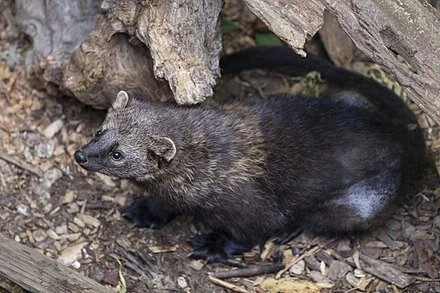Fishers are expanding into areas thick with humans
Fishers are powerful predators.
A fisher photographed in Topsfield, Mass.
From ecoRI News (ecori.org)
University of Rhode Island scientists have begun a three-year effort to capture and track fishers throughout western Rhode Island to better understand their population numbers and movement as the animals expand into more developed areas of the state.
Funded by the Rhode Island Department of Environmental Management, the project aims to gather data about the secretive predators, which are members of the weasel family, so that they can be managed more effectively.
“It’s fascinating to me to see how this creature that was once known as a deep dark forest-dwelling animal is now living in people’s backyards and in urban settings,” said Laken Ganoe, a University of Rhode Island doctoral student who is leading the project along with assistant Prof. Brian Gerber. “It’s a unique landscape for us to study a creature that we don’t know much about.”
Fishers are carnivorous mammals found throughout the forests of the northern United States and Canada. Extirpated from Rhode Island when forests were cleared for agriculture in the 1700s and 1800s, they have returned in recent decades and appear to be expanding their range in the region. They feed primarily on small mammals such as chipmunks and squirrels, though in more northerly regions their preferred prey is snowshoe hares.
In Rhode Island, fishers are legally trapped for their fur by licensed trappers during a 25-day trapping season in December.
Ganoe will use trail cameras set up at 200 sites in Providence, Kent and Washington counties to document where the animals are found. She also plans to capture up to 20 fishers in each of the next three years and place tracking collars on them to monitor their movements and activity levels throughout the day.
“We hope to learn how fishers are interacting with their environment in this matrix of urban and forested landscape,” Ganoe said. “Are they spending more time out and about in urban areas at night while being more active at dusk and dawn in forested areas?”
The name fisher may have originated from the French word fitchet, fitche, or fitchew used to describe the European polecat that has similar characteristics to the fisher.
“Tracking individual fishers for the winter will get a really fine scale idea about how they cross roads, what forests they are selecting for, what areas they’re avoiding,” Gerber said. “If we do it right and we’re lucky, we’ll be able to estimate how many fishers there are in certain regions of Rhode Island.”
A native of Clarion, Pa., Ganoe earned a master’s degree at Pennsylvania State University and studied fishers in the Sierra Nevada Mountains of California before enrolling at URI. She became interested in the animals as a teenager, when she watched as a fisher caught a chipmunk and ran up the tree from which she was hunting and ate it right beside her.
“There are a lot of misconceptions about fishers; they have a bad reputation,” Ganoe said. “We want to learn more about them so we can educate people about them. And because there is a trapping season for them, we want to inform future management decisions about bag limits and season lengths so we can properly manage the species.”
This is one of two research projects Gerber is leading that focus on learning more about Rhode Island’s mid-sized predators. The other is investigating the distribution of beavers, muskrats, and river otters in the state.

